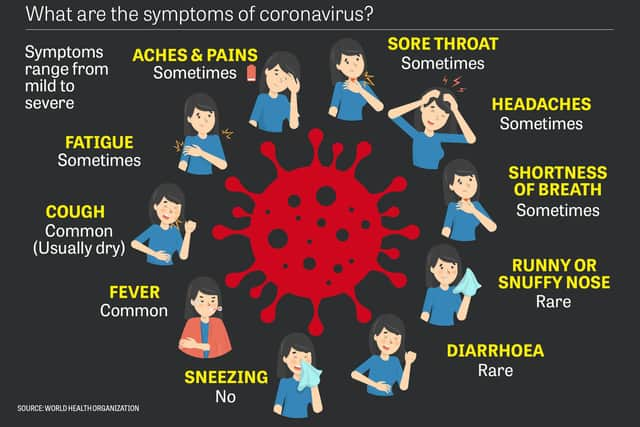Hay fever symptoms: how to tell them apart from coronavirus - and when hay fever season starts


They may also wonder whether suffering from hay fever makes you more susceptible to coronavirus, since it’s been said to affect those with respiratory conditions?
Here’s how to spot the difference between hay fever and coronavirus, and whether it puts you at risk.
Advertisement
Hide AdAdvertisement
Hide AdWhat’s the difference between hay fever and coronavirus symptoms?


Allergy UK advises that hay fever, or allergic rhinitis, can feature “a runny nose, blocked nose, cough, and sneezing. In some people, hay fever can trigger allergic asthma, causing a tight chest and difficulty breathing.”
While a wide variety of symptoms have been reported in connection with coronavirus, the two most common ones are a high temperature and a new, continuous cough.
Hay fever does not cause a high temperature, and according to Allergy UK it doesn’t make people feel unwell.
It can usually be easily treated with medications such as antihistamines and nasal steroid spray, which you can buy at a pharmacy.
What causes hay fever?
Hay fever is an allergic reaction to pollen from trees, grass and weeds, which occurs at a certain time of year.
The higher the pollen count – the amount of pollen grains in a certain volume of air - the more severe the symptoms are likely to be.
In the UK, a count of 50 or below is considered low, while 1,000 or above is considered high.
When is hay fever season in the UK?
Advertisement
Hide AdAdvertisement
Hide AdHay fever usually affects people in the early spring and summer months.
According to Allergy UK, different forms of pollen are likely to trigger it at different times:
- Grass pollen between May and July
- Tree pollen between February and September
- Weed pollen between June and September
The pollen count will also tend to be higher in the early part of the morning and the later part of the evening but it can remain high all day, decreasing at night as the air cools.
When the grass is damp, it will peak later in the morning as the water evaporates, releasing the pollen.
On sunnier days, the pollen count will be higher, while rain can wash the pollen away. However, days that are cloudy but dry will see the pollen build up to be released on the next sunny day.
However, there is also “perennial allergic rhinitis” which sees symptoms persist all through the year. It is usually triggered by indoor allergens like dust mites, pet hair or mould.
Does suffering from hay fever put you at risk of coronavirus?
The World Health Organisation advises that people with pre-existing conditions such as diabetes, asthma and heart disease are more at risk of becoming seriously ill if they contract the coronavirus.
Advertisement
Hide AdAdvertisement
Hide AdHowever, as of yet no connection has been made between hay fever and the coronavirus.
What should I do if I have symptoms of hay fever?
The Royal College of GPs has said sufferers should consider whether their symptoms are the same as in previous years.
Dr Jonathan Leach told the BBC: "For most people who have hay fever it is the same symptoms as they have each year.
"What we are finding is that some patients are saying 'look this is a different thing to what I had last year, could this be coronavirus?' and in that case it might be."
GPs are advising patients who are unsure or who are having trouble breathing that they should phone their doctor or use the NHS 111 online coronavirus service.